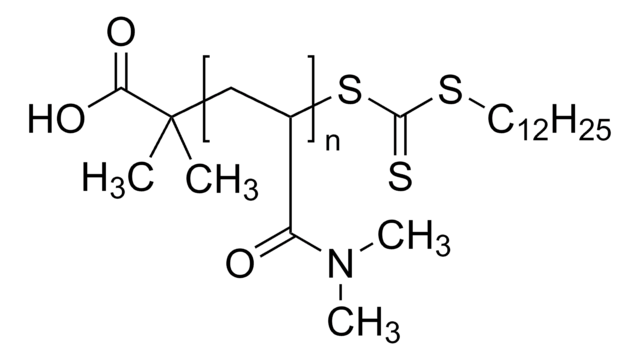529265
Poly(méthacrylate de 2-hydroxyéthyle)
average Mv 20,000
Synonyme(s) :
Poly(2-HEMA), Poly-HEMA
Sélectionner une taille de conditionnement
Sélectionner une taille de conditionnement
About This Item
Produits recommandés
Forme
powder
Niveau de qualité
Poids mol.
average Mv 20,000
Température de transition
Tg 84.8 °C
Densité
1.15 g/mL at 25 °C (lit.)
Chaîne SMILES
CC(=C)C(=O)OCCO
InChI
1S/C6H10O3/c1-5(2)6(8)9-4-3-7/h7H,1,3-4H2,2H3
Clé InChI
WOBHKFSMXKNTIM-UHFFFAOYSA-N
Vous recherchez des produits similaires ? Visite Guide de comparaison des produits
Application
- Hydrogen-bonds structure in poly(2-hydroxyethyl methacrylate) studied by temperature-dependent infrared spectroscopy: Investigates the hydrogen-bond structure in poly(2-hydroxyethyl methacrylate) (PHEMA) using temperature-dependent IR spectroscopy. (S Morita, 2014).
- Transparent and tough poly(2-hydroxyethyl methacrylate) hydrogels prepared in water/IL mixtures: Describes the development of tough and transparent PHEMA hydrogels for potential use in various biomedical applications. (Y Liu et al., 2020).
- Reduced cell attachment to poly(2-hydroxyethyl methacrylate)-coated ventricular catheters in vitro: Examines how PHEMA coatings can reduce cell attachment, which is beneficial for biomedical devices like catheters. (BW Hanak et al., 2018).
- Surface modification of poly(2-hydroxyethyl methacrylate) hydrogel for contact lens application: Studies modifications to PHEMA hydrogels to improve their suitability for contact lens applications. (M Kazemi Ashtiani, M Zandi, 2018).
Forme physique
Code de la classe de stockage
11 - Combustible Solids
Classe de danger pour l'eau (WGK)
WGK 3
Point d'éclair (°F)
Not applicable
Point d'éclair (°C)
Not applicable
Équipement de protection individuelle
Eyeshields, Gloves, type N95 (US)
Faites votre choix parmi les versions les plus récentes :
Déjà en possession de ce produit ?
Retrouvez la documentation relative aux produits que vous avez récemment achetés dans la Bibliothèque de documents.
Les clients ont également consulté
Articles
Professor Shrike Zhang (Harvard Medical School, USA) discusses advances in 3D-bioprinted tissue models for in vitro drug testing, reviews bioink selections, and provides application examples of 3D bioprinting in tissue model biofabrication.
Self-assembled monolayers (SAMs) have diverse applications; article compares benefits of alkylthiolates on gold SAM systems.
Biomaterials science integrates smart materials into biological research, requiring a deep understanding of biological systems.
Protocoles
Frequently asked questions (FAQs) for KAPA SYBR® FAST One-Step qRT-PCR Kits.
Active Filters
Notre équipe de scientifiques dispose d'une expérience dans tous les secteurs de la recherche, notamment en sciences de la vie, science des matériaux, synthèse chimique, chromatographie, analyse et dans de nombreux autres domaines..
Contacter notre Service technique










